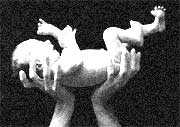What to Do When a
Newborn Can’t Hear
Main
Article page | Family topics |
Health page|
Fitness articles|
Diseases

By PERRI KLASS, M.D.
An
extensive trail of subspecialists had evaluated him
after that first test showed severe hearing loss in
both ears. A geneticist, a developmentalist, a
kidney specialist — no one could find anything
wrong. He was a healthy, cheerful child who couldn’t
hear very well.
Nowadays, 97 percent of babies born in this country
have their hearing screened in the newborn nursery.
(More in a minute about the clever technologies that
make this possible.) That means essential follow-up
testing and treatment can begin very early indeed.
But the key term is “follow-up.”
As many as 46 percent of children who failed the
newborn screening test in 2007 did not have
documented repeat testing and treatment, said Marcus
Gaffney, a health scientist with the Early Hearing
Detection and Intervention program at the Centers
for Disease Control and Prevention.
“Screening a child doesn’t do a lot of good,” Mr.
Gaffney told me, “if you don’t take the appropriate
follow-up.”
Before newborn screening changed the picture in the
late 1990s, the average age for diagnosing hearing
loss was about 2 ½. And the testing was usually done
only because the child’s speech was slow to develop.
In children with relatively mild hearing loss, or
loss in only one ear, it sometimes took even longer.
“Hearing loss has often been thought of as the
silent disability,” said Dr. Judith E. C. Lieu, a
pediatric ear, nose and throat specialist at
Washington University in St. Louis. It may be hard
to spot even in older children, she went on: “It may
look like not paying attention; they talk while the
teacher is talking.”
Dr. Lieu is the author of a new study showing that
even hearing loss in only one ear is linked to
poorer language skills in children.
But invisible or silent as it may be, hearing loss
is one of the most common congenital disabilities,
affecting 2 to 4 of every 1,000 babies. It can be
genetic, or it may result from prenatal infection:
Of the so-called TORCH infections that can attack a
developing fetus (the letters stand for
toxoplasmosis, rubella, cytomegalovirus, herpes and
“other”), several can damage hearing.
Back before immunization, rubella was the major
menace, causing deafness, hearing loss and brain
damage. Now the most common culprit is
cytomegalovirus, an infection that may not cause any
symptoms in a pregnant woman but can affect her
developing fetus, especially if she contracts it in
the first trimester. Hearing loss from
cytomegalovirus can be severe, but may develop only
after the child is born.
Premature infants, or those sick enough to need time
in the newborn intensive-care unit, are also at risk
for hearing loss, sometimes from oxygen deprivation,
sometimes from severe infections and sometimes from
medications.
Then there are the genetic factors, which are
remarkably complex. Hearing loss can be part of more
than 400 genetic syndromes; that’s why my patient
had his kidneys checked (Alport syndrome), and why a
geneticist went over his physical exam looking for
unusual facial features (Waardenburg syndrome, among
many others).
In cases that do not involve a syndrome, more than
100 different genes may be implicated. Parents are
not necessarily aware that the problem exists in
other family members; inheritance patterns vary with
the specific genetic abnormalities, and as many as
95 percent of children with genetic hearing loss are
born to parents with normal hearing.
So how do you test a newborn’s hearing? There are
two different technologies. In otoacoustic
emissions, a tiny microphone is inserted into the
ear of the sleeping newborn to measure echoes from
the cochlea when it is stimulated by sound. With
automated auditory brainstem response testing, a few
small sticker electrodes are placed on the baby’s
head to measure the brain’s response to small
sounds.
The test is the first step in the so-called 1-3-6
plan: screen every baby by 1 month of age, do a
diagnostic evaluation on all who fail by 3 months,
and get those babies into treatment by 6 months.
Research done in the 1990s by Christine
Yoshinaga-Itano, a professor of audiology at the
University of Colorado, showed that children who got
help by 6 months had better speech and language
development than those who were identified later.
Help can come in the form of speech and language
therapy; counseling and training for parents; and
amplification, including hearing aids, if necessary.
By the time the 8-year-old boy became my patient, he
was seeing a speech therapist regularly and he was
talking quite well.
Children who are born with normal hearing and pass
their screening, but develop hearing loss after
birth, may be missed. When the question of speech
delay in a 1-year-old comes up in our clinic, we
have to guard against feeling complacent because the
child passed the test at birth. Newborn screening
doesn’t prevent the development of problems later
on: “It’s not a vaccination,” said Brian Fligor,
director of diagnostic audiology at Children’s
Hospital Boston.
After all, hearing can deteriorate after birth as
well — and the cause can be genetic factors,
cytomegalovirus or damage from head trauma,
meningitis or exposure to very loud noise.
“Hearing loss can develop any time in childhood,”
Dr. Lieu told me. “Any time a parent has a concern
about a child’s hearing, whether it’s selective
hearing, or speech and language, they really need to
check out the hearing.”


